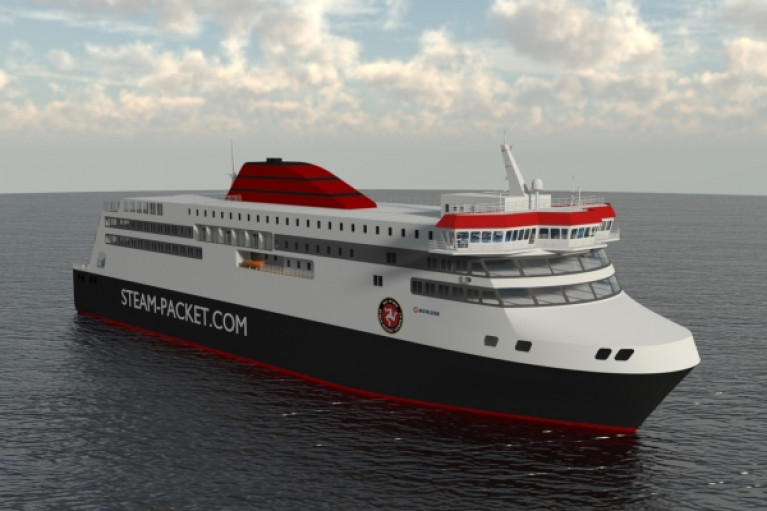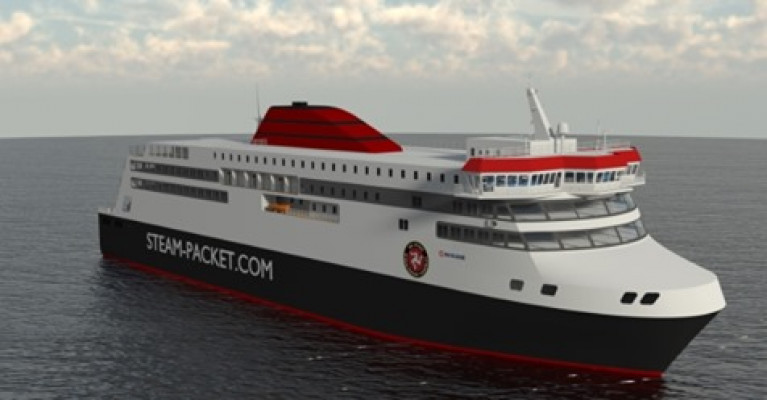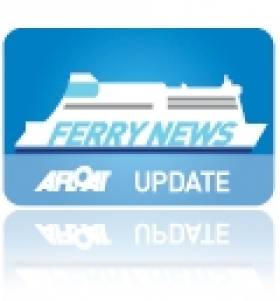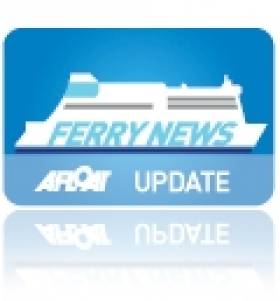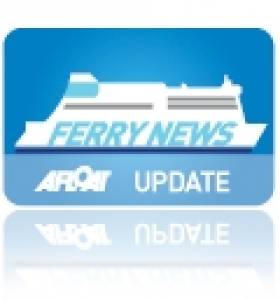Displaying items by tag: IOMSPCo
Manxman is the name chosen for the new Isle of Man Steam Packet Company ferry following an online public consultation.
The announcement follows months of deliberation by the Manx ferry company, which in October announced a shortlist of four potential names – Manxman, Mona’s Isle, Manx Maid and King Orry - all of which are traditional Steam Packet Company vessel names.
Throughout November, the public had the opportunity to voice their preference for the name of the new purpose-built ferry as Afloat reported is to be built in Asia. The newbuild due in 2023 is to be flagged and registered under the Isle of Man Register and will replace the Ben-My-Chree.
More than 7,500 people took the opportunity to suggest their favourite of the shortlisted names. Out of these, it was Manxman and King Orry that emerged as the most popular choices by a considerable margin. These two favourites were then considered further by the company and the name Manxman was chosen. This will mark the third ship in the Company’s history to bear the name, the last a turbine steamer launched in 1955.
Isle of Man Steam Packet Company Chief Executive Mark Woodward said: ‘After much thought and deliberation, we are excited to announce the name of our bespoke, custom-built vessel. King Orry and Manxman were both clear favourites, however, with more than 65 years having passed since the launch of our last ship called Manxman - compared to just 20 years since we named a vessel King Orry, we feel that now is the right time for the return of Manxman. It is a name that embodies the Manx spirit, signifies national pride and is suitably enduring for a vessel that will take the Steam Packet Company into its 200th year and beyond. She will be a fine addition to our fleet.
‘We would like to thank everyone who took the time to express their views on the four shortlisted names. It was pleasing to see such interest and, of course, to take the public’s views into consideration when making the final decision - something we thought very important.’
Shipbuilders in Asia are to custom-build a ferry for the Isle of Man Steam Packet Company at a facility in South Korea with the newbuild due to enter Irish Sea service in 2023.
The agreement was officially confirmed yesterday by the Manx operator's Board of Directors, having signed a contract with one of the world’s major shipbuilders, Hyundai Mipo Dockyard (HMD), based in Ulsan.
It follows a week-long visit to Korea by senior personnel from the IOMSPCo, during which they visited the shipyard where the vessel will be built, viewed a recently completed ship to assess the standard of work and discussed technical and commercial considerations with HMD executives.
Work on physically constructing a replacement for the conventional ferry, Ben-my-Chree, is now due to start in mid-2021 after detailed plans are finalised and agreed between builder and buyer.
The process began last autumn when the Company commissioned a tender exercise, during which a large number of shipyards around the world expressed an interest in building the bespoke vessel.
Isle of Man Steam Packet Company Chief Executive Mark Woodward said: ‘For some time we have been conducting detailed analysis as we develop plans for major investment in our fleet. ‘I am delighted to confirm that, following lengthy discussions with a leading shipyard in South Korea, we have confirmed specifications for the vessel and today signed a contract with Hyundai Mipo Dockyard.
‘This truly is an exciting time in our history and, in the year we marked our 190th anniversary, the new vessel will take the Isle of Man Steam Packet Company forward to our 200th anniversary and beyond.’
The new vessel, expected to commence service in Spring 2023, will be an important part of the Company’s future plans, bringing high levels of on-board facilities and enhanced freight capability.
The Company is also committed to maintaining a third back-up vessel, intended to be the Ben-my-Chree when the new vessel arrives, to enhance security of both passenger and freight links and also help increase capacity during the TT and Classic TT.
Mr Woodward continued: ‘The final specification and build programme is still in development but it is expected the new vessel will be slightly larger than the Ben-my-Chree in most respects but with considerably more passenger space. It is also intended to be more environmentally efficient and manoeuvrable in poor conditions.
‘Factoring in various technical and logistical considerations for a new vessel, and taking into account the recent public consultation exercise where possible, our aim for when we introduce the new addition is to ensure we provide an even higher level of service to the Island community and our customers.’
Dublin-Douglas December Winter Sailings
#MANX FERRY- In preparation for the busy festive season, the Isle of Man Steam Packet Co. (IOMSPCo) are to deploy Ben-My-Chree to operate two round-trip Douglas-Dublin Port crossings, writes Jehan Ashmore.
The ro-pax (90-freight trailer/630 passenger) ferry is scheduled to depart Douglas on Saturday 22 December at 19.30hrs with an arrival in Dublin Port at 00.15hrs on the morning of Sunday 23 December. The return sailing departs the Irish capital at 01.00hrs.
On the following weekend, Ben-My-Chree heads for the 4 hour 45 minute Irish route again on Saturday 29 December, departing Douglas at 19.30hrs and arriving in Dublin just after mid-night at 00.15hrs. The return crossing on Sunday 30 December to the Manx capital departs 01.00hrs.
For updates on sailing schedules to include Manx-UK routes between Douglas-Heysham and the winter only operated Douglas-Liverpool (Birkenhead) route visit: www.steam-packet.com/en/LatestSailings
Plans for Wind-Farms Won’t Affect Manx Ferry Operator
#MANX FERRY – The IOM Today reports that the Manx Government is drawing up plans to ensure that any wind-farms built within the waters off the island would not affect ferry routes.
Work on the Isle of Man Marine Plan is under way and the Department of Environment, Food and Agriculture's director of environment Martin Hall said it was important it was completed in a 'timely manner'.
One of the plan's objectives would be to identify current activities in Manx waters and safeguard their ongoing use. Mapping the location of navigation corridors, important natural areas and pipelines/cables will enable the island to identify potential wind farm sites that will not adversely affect current uses of the Manx marine environment, including ferry routes and fishing.
The comments come following criticism from the Isle of Man Steam Packet Company over Centrica's plans for a wind farm in the Irish Sea, outside Manx waters. The Steam Packet says that Centrica plans to develop in the path of two routes: Douglas-Liverpool and Douglas-Heysham, in spite of complaints from the ferry operator. For much more on this story click HERE.
Former US Navy Fast-Craft Re-opens Seasonal Dublin Route
Manannan's chequered career included a five year charter initially to the United States Navy but transferred to the United States Army Forces between 2001-2006. The 5,029grt craft (see photo) was used for various trials and demonstrations and in which saw service in the Persian Gulf in support of 'Operation Iraqi Freedom' and in 2003 'Operation Enduring Freedom' in the Horn of Africa.
An engine plant of 4 x Caterpillars diesel generates a speed of over 40 knots / 46 mph which provided logistical solutions by the High-Speed Vessel (HSV) to transport troops and supplies covering long distances in support of the Combined Joint Task Force.
Other tasks required by the force included the roles of operating as a mobile command centre which entailed working closely inshore and operating as a helicopter carrier. Helicopters landed at the craft's stern positioned helicopter landing deck.
The military role of the craft is in stark contrast compared to when the 96m ferry was launched in 1998 for civilian purposes as the Incat 050, the number representing the number of pioneering wave-piercing craft built by InCat in Hobart, Tasmania.
Asides her military days the 800-passenger / 200 vehicle fast-ferry has served the Hobart-Melbourne route, between New Zealand's north and south island and in European waters in the Mediterrean and to the Canary Islands.
Manannan (see photo) entered service last May after the Isle of Man Steam Packet Company (IOMSPco) purchased the vessel which was laid-up in Hobart. She made the long delivery to the northern hemisphere and was re-converted for ferry usesage during a refit in Portsmouth.
The 181 year-old company is the only sea-based passenger operator to the island on services linking Dublin, Belfast, Heysham, Liverpool and (Birkenhead) in the winter months.
There are rival companies such as the Ramsey Steamship Company but they are freight-only operators mostly running to Belfast and Liverpool using short-sea coastal traders and to other small Irish Sea ports.
An annual round island cruise is held and like last year the Manannan will be serving the cruise on Sunday 1 May departing Douglas at 11am for a journey of around 2 hours. The route closely circumnavigates the spectacular Manx coastline. For information on the island cruise and fares click here.



























